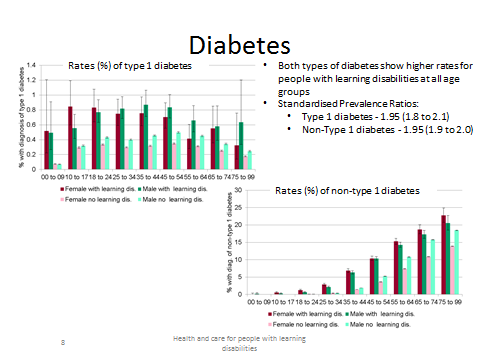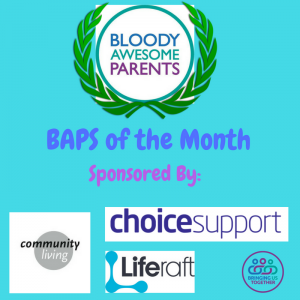People with learning disabilities die younger from conditions that can be better managed
While at a conference recently, we heard some frightening statistics and we wanted to share them with you. We want to hear about your experiences
Evidence shows that people with learning disabilities die younger from conditions that can be better managed.
There are a lot of barriers preventing people with learning disabilities accessing public services. Then even if they do, there are other barriers that makes ongoing care a challenge for people with learning disabilities and their families.
The Learning Disability Programme identified four long term conditions commonly being reported as a causes of death and/or poor health outcomes.
- Diabetes
- Epilepsy
- Heart Disease
- Dysphagia
Diabetes:
A friend of mine recently had a daughter diagnosed with Diabetes Type 1, her daughter also has ASD. I can still remember her ringing and asking “what do I do now?”
There was no support for her to manage her daughter’s diabetes and learning disability. She could find lots of info on diabetes and lots of info on learning disabilities but none for the two together. I put her in touch with another friend who has a daughter with diabetes who I knew was active in several groups and she managed to hook her up with another mother in the same position. I asked her recently how it was going having someone else who understood and she said “it is so good having someone who relates to the asd side too and whose brain I can pick as the focus with diabetes seem to be around food and people don’t seem to understand that asd children have a lot of issues round foods”
How can parents of Children with Type 1 & LD help us?
We want to know about your experiences of getting support, the issues you faced with possible diet changes and similar? What worked for you? If you could share tips with one other family in your position, what would you recommend?
Why do we need to look at this?
- Obesity is a risk factor for developing type 2 diabetes
- Research shows overwhelming evidence that the rate of obesity in people with learning disabilities is significantly higher than for the general population, (28% compared to 20%).
- Young people with LD have a higher risk of developing Type 2 diabetes as a result of a higher prevalence of obesity.

this chart shows any condition whose line goes past 1 has higher rates than that of the general population.
Factors contributing to obesity include:
- lower physical activity,
- lack of skilled staff,
- lack of dietary advice,
- limited availability of leisure facilities,
- genetic predisposition (24-48% adults with Down’s Syndrome are obese).
With young people with no LD, lifestyle changes can be easier to manage. However, young people with LD can struggle to access physical activity and dietary advice, and for many, changes in diet can be a real struggle due to sensory and other issues.

A report from IHaL Conference last year shows higher rates of both type 1 and type 2 diabetes for people with learning disabilities compared to those without learning disabilities.
Complications of Type 2 Diabetes
- Diabetes can cause serious long-term health problems. It’s the most common cause of vision loss and blindness in people of working age.
- Diabetes is also responsible for most cases of kidney failure and lower limb amputation, other than accidents.
- People with diabetes are up to five times more likely to have cardiovascular disease, such as a stroke, than those without diabetes.

What can we do?
We are doing a small piece of work with NHS England to look at the experiences of families around access to the services and support they need.
Do you have a child with a learning disability? We will be posting a few questions in the next week asking about your experiences.
Do you have a child with a learning disability and diabetes? We would love to hear about your experiences. What has helped? What were the barriers? Did you overcome them or are they still an issue?
In December we will be hosting a small FB Live chat to talk to families about this and then in January we will be bringing families together. We will be able to advise on venue, etc once we can see where the families are. We will find somewhere easy for the majority to get to.
If you would like to be involved, get in touch with Katie@bringingustogether.org.uk
The BBC have recently reported on the issues facing patients with diabetes -types 1 and 2 – you can read more about it here
Mum to three great kids, each with a different SEN.
Transplanted from the NW to the SE.
Co-founder and Director of Bringing Us Together








hi ,
i am a sibling carer ,my sister began some 15 years ago breakout in rashes i approached my G P for advise he gave me tubes cream to rub into the affected part, nothing appeared to happen, i spoke to a friend about this who was a diabetic, she told me my sister also be a diabetic , and suggested i go to my chemist and by a digital blood reader .
i did this to my astonishment the reading deride 38- 47 i immediately contacted our G P to discuss the reading my impression was he went into a panic and prescribed met-forming two 500 mg tablets three time a day i was not happy with this so went to have a talk with outpatients nurse about my concerns the nurse agreed this was to high and suggested one 500 mg three times a day would be better we had a brief conversation about food and exercise i re-approached our GP who by now seemed to have got to grips about the reading , well the rest is history healthy food regular exercise and medication we have up till now managed the blood counts down to between 5 -7
sibling carer
don